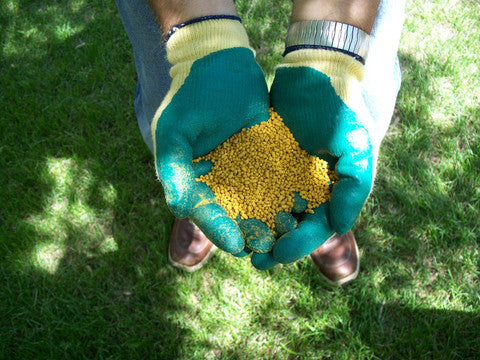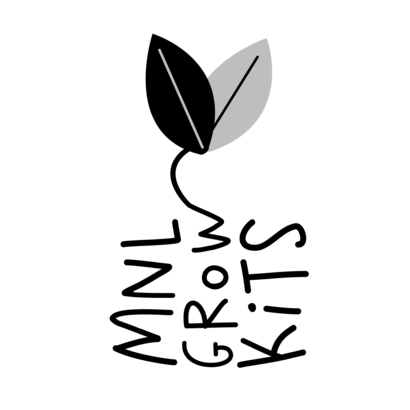The Basics of Fertilization
Just like math or your failed relationship, understanding fertilizers can be tricky and sometimes overly complicated. But for all budding #growers, solid basic knowledge about fertilizers and how to use them effectively is very crucial to ensure successful plant growth (and yes, mental and emotional stability when trying to grow your plants).
So for the betterment of your plants, we’ll try our very best to provide you with some basic knowledge about fertilizers and briefly discuss what, when and how to use them.
3 Prime Chemical Elements in Fertilizers
Whether organic or inorganic you’ll encounter these three prime chemical elements in your fertilizers.
N = Nitrogen promotes healthy leaf growth by stimulating the production of chlorophyll (the main chemical involved in photosynthesis—how plants convert sunlight to food).
P = Phosphorus supports the vigorous development of roots, stems, blossoms, and fruits.
K = Potassium plays a key role in helping plants digest and manufacture their foods.
Why Fertilization is Important
You might be surprised to know that all the nutrients essential to plant growth are present in the soil or just floating up there in the air, crazy right? So what’s the point of fertilizing then?
Well, it’s because of the simple fact that not all plants can access these nutrients found in the soil or in the air. Add the fact that each soil type has its own “nutritional composition” so it’s really important to consider this when choosing your fertilizer. A lot of things can affect your soil’s “nutritional composition”.
Factors like pollution, past farming activities and even weather can greatly affect and alter soil chemistry and structure making the nutrients “inaccessible” to plants. And most often than not, most of these nutrients aren’t naturally there to begin with or have been “depleted” over time. All these and a whole lot more requires us to replenish, replace and aid our plants to reach and access these nutrients for them to use.
Contrary to popular belief, it’s NOT GOOD to over fertilize. More fertilizer doesn’t necessarily mean more fruits and better foliage. Over fertilization can damage or even kill your plants. We highly recommend that you have your soil tested so you can choose the type and formula that suits your soil’s structure and chosen plant.
Types of Fertilizer
Since we advocate organic farming, when we say Fertilizer, we generally mean Organic Fertilizers. There can be a lot of variations of fertilizers but to simplify things we’ll mention 3 of the most common.

1) Liquid based fertilizers
Liquid based fertilizers are usually dilluted in water and is applied by watering it directly to plants. Your liquid fertilizer can either be the common water-soluble fertilizer or the foliar type.
2) Water-soluble fertilizer
With this fertilizer, nutrients are “fed” into the plants while you water. Water-soluble fertilizers usually come in concentrated form which requires you to dillute them first prior administering. Dillution rate varies from brand to brand so make sure that you read your chosen fertilizer’s manual before using them.
3) Foliar Fertilizer
Another type of liquid fertilizer, foliar fertilizer’s route of entry is via plants’ leaves. Instead of watering it to the soil, foliar fertilizers are generally applied to the leaves. Just like water-soluble fertilizers dilution rate varies from brand to brand
4) Solid Type Fertilizers
Solid type of fertilizers usually come in different forms. You can buy them in powder, pelletized, spike or even in crumble form. There are a lot of choices depending how often you want to fertilizer your plants. Generally speaking fertilizers in powder form are the fastest to act on your plants while pellets, spikes and crumbles gradually release as you water your plants.
As with any solid type of fertilizer, they are usually administered directly on the soil either before or during the planting season. Unlike water-soluble fertilizers, solid types has the capability to “rehabilitate” your soil and bring back its lost nutrients.
Fertilizers for Different Purposes
Nitrogen, phosphorus and potassium. We can’t give more weight to these three essential elements. Each element function differently from one another. The content of your essential elements are stated as numbers on your fertilizer’s packaging, usually in this format #-#-#. For example if you see 3.5-4-5 this means that each element – N, P, and K – contributes a total of 12.5 percent by weight to the total formula. The remaining percentage out of 100 is usually composed of inert materials and trace elements.

With chemical fertilizers (eew) the element percentages are usually in varying proporitions to suit different plants and fertilizer needs. Also, if given the chance for you to compare NPK percentages of organic and inorganic fertilizers you’ll notice that inorganic fertilizers usually have higher NPK than organic fertilizers. Here in the Philippines the approved maximum NPK for organic fertilizer is around 10%. Any fertilizer that has higher NPK than the approved limit is considered to be either inorganic or fortified organic fertilizer. That basically means that your fertilizer has sythetic or chemical elements in it. (slight eew).
Other than NPK, most fertilizers, both organic and inorganic usually contain traces of other elements important to a plant’s health. Importance and function of every trace element varies greatly but each has one purpose, to nourish a plant in its own way. Other trace elements in fertilizers include calcium, magnesium, iron, copper, manganeze, boron, sulfur and molybdenum. Your plant will quick to remind you if ever they are lacking of these mentioned elements by showing deficiency symptoms, either by changing their color or by withering.
Picking the right fertilizer for your plants
As mentioned above, fertilizers come in two major types. Water solubles and solid types. Just like any choices in life, each has pros and cons. Solid type of fertilizers deliver food to a plant slowly (but surely). They are the go-to fertilizers if you’re aiming for longevity. As nutrients are usually distributed when you water your plant, they do not leach out of the soil as rapidly as their water-soluble counterparts. If you’re looking for a quick fix, you might want to go for water-soluble fertilizers. Water soluble-fertilizers acts fast but you need to apply more frequently than its rival, the solid types.

There’s actually no reason for us to throw both fertilizer in a sparring showdown because both thyper are effective. It all boils down to your preferences and of course your plant type and stage. If you’re the busy type nothing beats time-release granular fertilizers but if you’re the clingy type water-solubles will be your best bet. J
Some tips when applying your fertilizers
We’ll say this again. OVER FERTILIZATION IS NOT COOL! In fact, they may cause “burning” of your plants. Also avoid applying fertilizer on a windy or overly rainy days. This can cause your fertilizers to be misplaced and ineffective. Never apply solid-type of fertilizers when the soil is extremely dry and be sure to water it thoroughly after applying to prevent plant burn.
So, when do you fertilize?
This is tricky since most fertilizers has their own fertilization protocols. We strongly suggest you read instructions and recommended dosage of your chosen fertilizers in the leaflets or on its packaging. Generally for any solid-type of fertilizer you can fertilizer once every 2 weeks and every 2-3 days for foliar fertilizers. There’s actually no concrete rule on when to apply your fertilizer. There are only guides and recommendations so be wise and ask around for further tips and info.
